外研版(2019)选择性必修 第二册Unit 3 Times change! Developing ideas课件(共32张PPT)
文档属性
| 名称 | 外研版(2019)选择性必修 第二册Unit 3 Times change! Developing ideas课件(共32张PPT) |
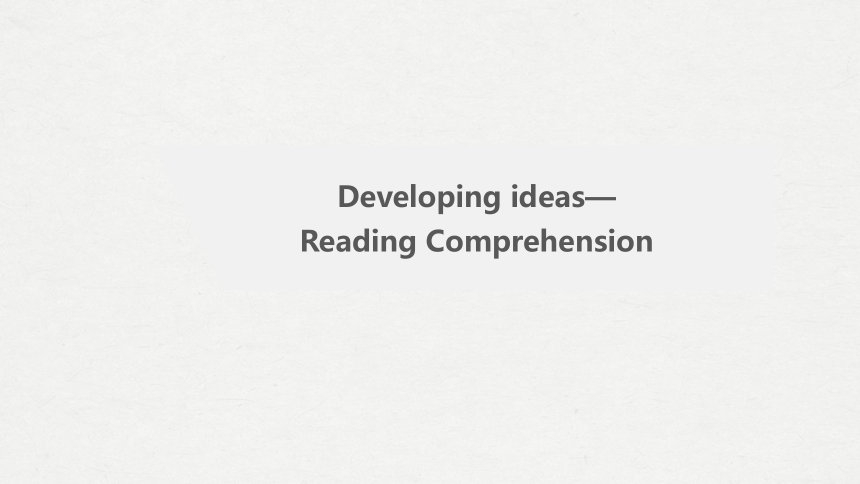
|
|
| 格式 | pptx | ||
| 文件大小 | 12.0MB | ||
| 资源类型 | 教案 | ||
| 版本资源 | 外研版(2019) | ||
| 科目 | 英语 | ||
| 更新时间 | 2024-04-29 14:08:58 | ||
图片预览

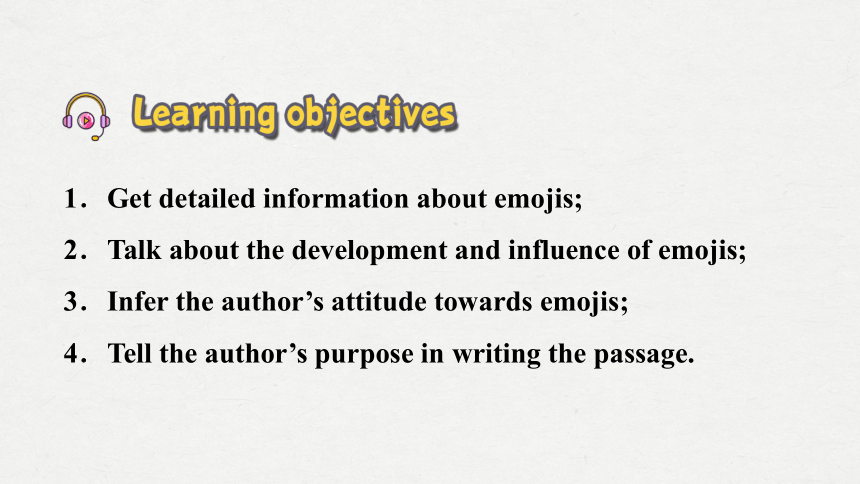

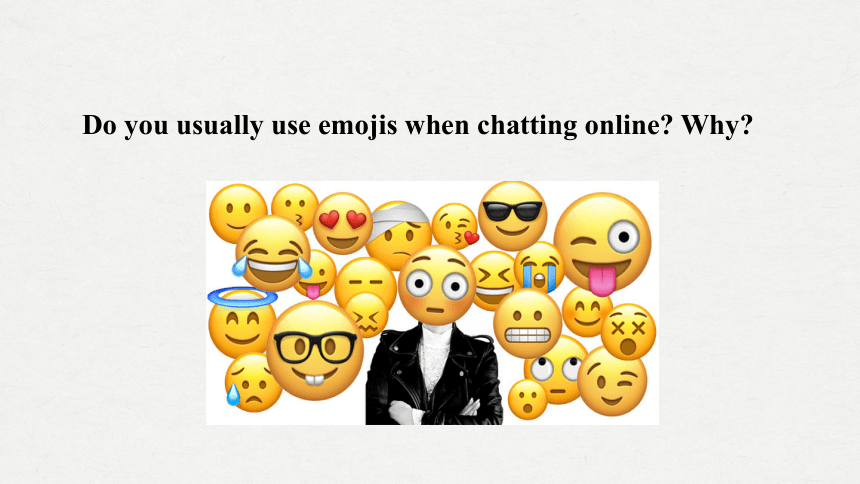
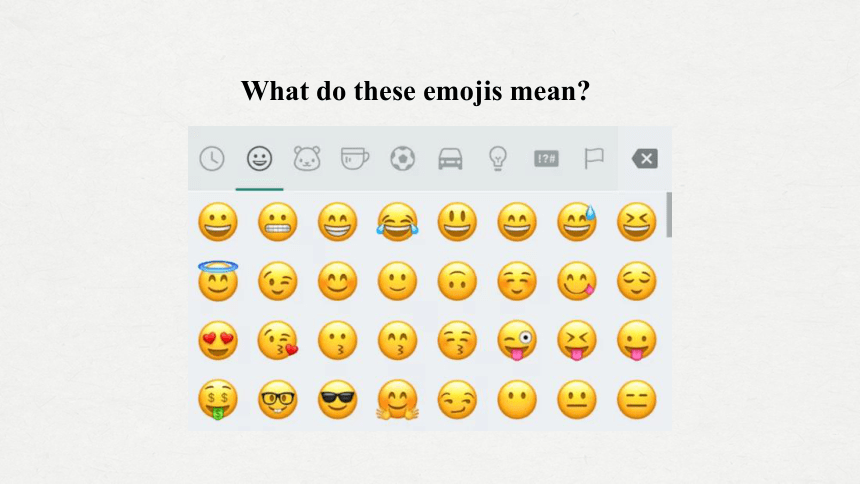
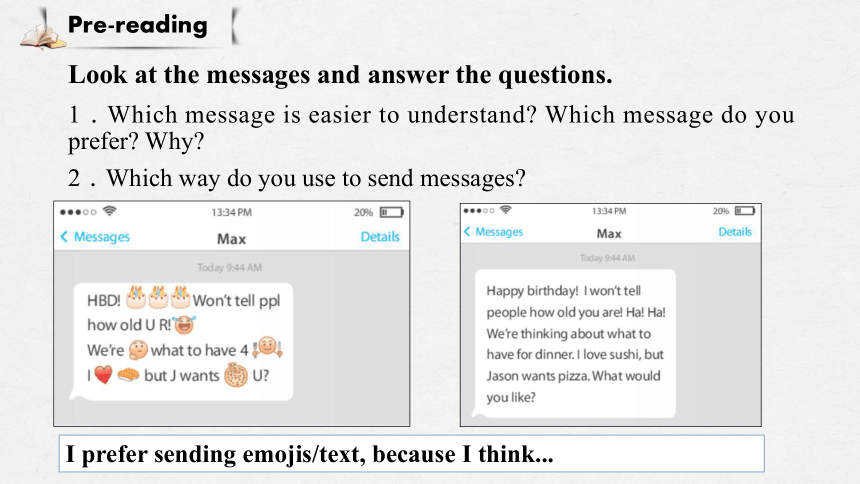
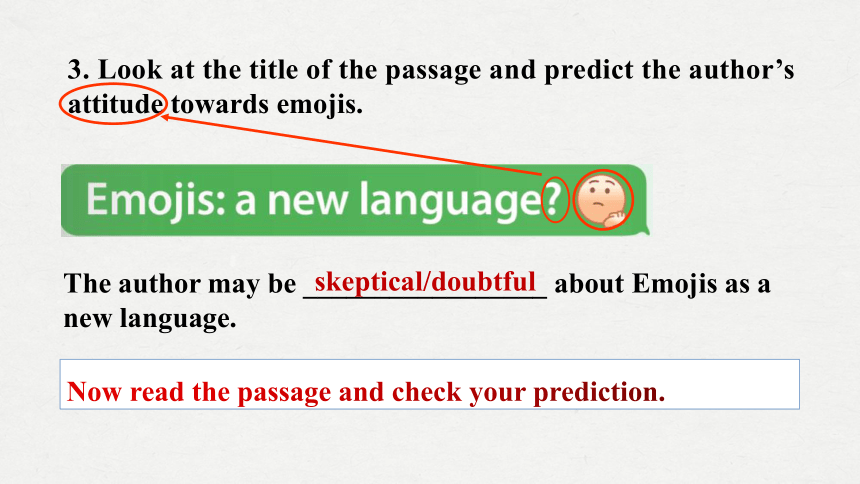
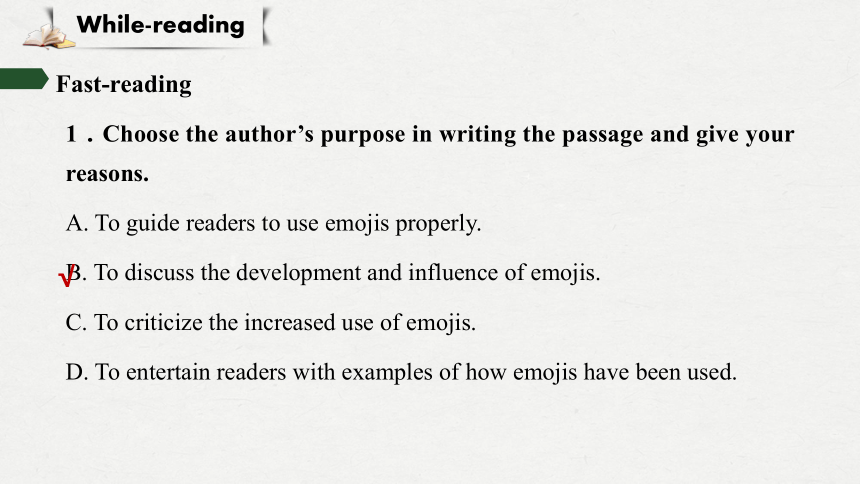


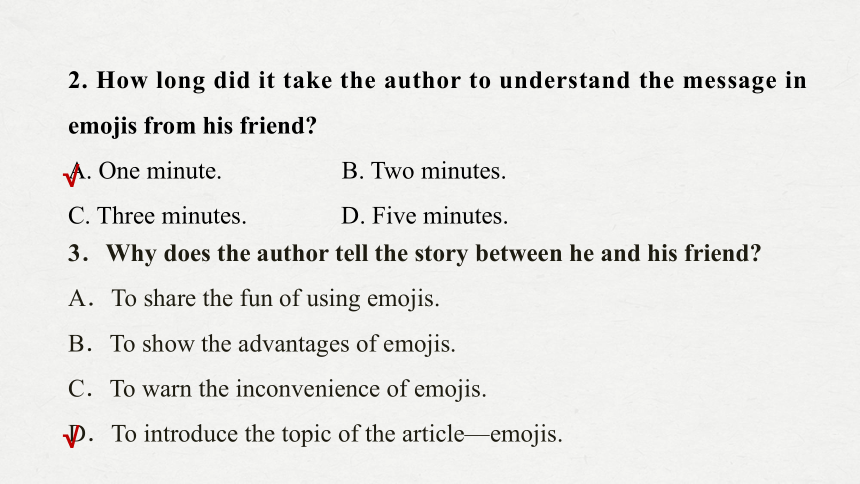
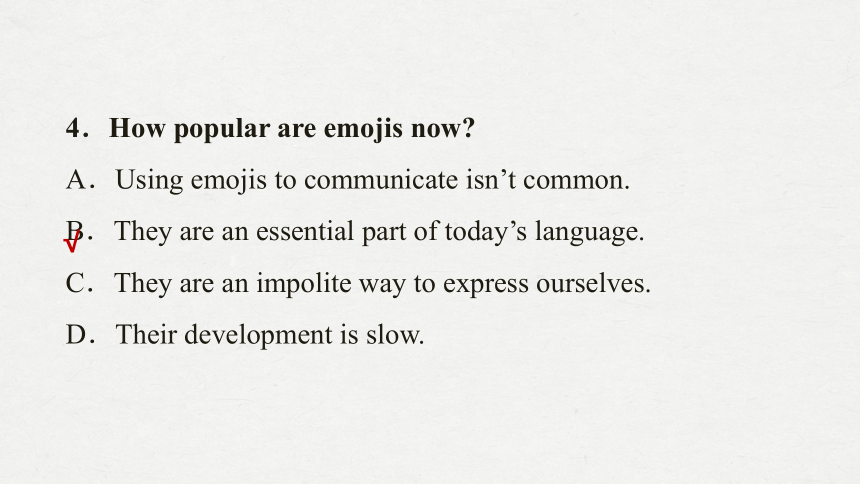
文档简介
(共32张PPT)
Developing ideas—
Reading Comprehension
1.Get detailed information about emojis;
2.Talk about the development and influence of emojis;
3.Infer the author’s attitude towards emojis;
4.Tell the author’s purpose in writing the passage.
Nowadays more and more such symbols are widely
used in our daily life...
Lead-in
Do you usually use emojis when chatting online Why
What do these emojis mean
Look at the messages and answer the questions.
1.Which message is easier to understand Which message do you prefer Why
2.Which way do you use to send messages
Pre-reading
I prefer sending emojis/text, because I think...
3. Look at the title of the passage and predict the author’s attitude towards emojis.
The author may be _________________ about Emojis as a new language.
skeptical/doubtful
Now read the passage and check your prediction.
1.Choose the author’s purpose in writing the passage and give your reasons.
A. To guide readers to use emojis properly.
B. To discuss the development and influence of emojis.
C. To criticize the increased use of emojis.
D. To entertain readers with examples of how emojis have been used.
While-reading
Fast-reading
√
2.The structure of the passage:
Part 1: Paras. (_____)
Introducing the topic by the author’s examples.
Part 2: Paras. (_____)
The origins and development of emojis and its application in daily life.
Part 3: Para. (_____)
The future development and the author’s concern.
1-3
4-7
8
Read Part 1 and answer the question.
1.What is the meaning of each message
“I’d be running late and would be there soon.”
“OK, don’t rush.”
Careful-reading
Paras. 1-3
2. How long did it take the author to understand the message in emojis from his friend
A. One minute. B. Two minutes.
C. Three minutes. D. Five minutes.
3.Why does the author tell the story between he and his friend
A.To share the fun of using emojis.
B.To show the advantages of emojis.
C.To warn the inconvenience of emojis.
D.To introduce the topic of the article—emojis.
√
√
4.How popular are emojis now
A.Using emojis to communicate isn’t common.
B.They are an essential part of today’s language.
C.They are an impolite way to express ourselves.
D.Their development is slow.
√
Guess the idioms(成语) with emojis in Chinese.
鸡飞蛋打
七嘴八舌
人走茶凉
心照不宣
Play a game:
Read paras. 4-7 and answer the questions.
1.The word “emoji” comes from ________.They are symbols which represent ________________________.
2.Emojis come in different categories except _____.
A.faces and people
B.plants and animals
C.food and drink
D.traditional English words
Japanese
ideas, emotions or feelings
Find the detail in paragraph 4 and understand it.
Para. 4
√
3.The development of emojis:
In 1999, there were only______ simple designs.(Designed by Shigetaka Kurita栗田穣崇)
Now, there are more than ______ emojis that expand upon the way in which we communicate.
176
3,000
4. Deep thinking:
What can you infer from the contrast
Para. 5
They are developing as the time changes.
牛津字典年度热词
5. What is the Oxford Dictionaries Word of the Year in 2015
The emoji “ ”.
6. Choose the advantages of emojis over written language.
a.They add emotional meaning.
b.They are slow.
c.They are hard.
d.They can make others really see your facial expression.
e.They can help express your feelings.
f.They can replace words sometimes.
quick
easy
“see”
Deep thinking:
Can you think of other advantages
Para. 6
√
√
√
The use of emojis in classical literature.
A Shakespeare series for young readers has taken William Shakespeare’s popular plays and replaced some words with textspeak and emojis.
Example:(find the detail in the text)
Advantage:
The intention of these adaptations is to make the classics more accessible to young readers.
Disadvantage:
Some people believe that these new versions have taken away the heart and soul of Shakespeare’s plays.
Para. 7
1.Which of the following is NOT a reason why educators are worried about the use of emojis
A.Because we may not be able to communicate in language one day.
B.Because people prefer emojis to written and spoken words.
C.Because people probably will completely rely on the pictorial language to communicate.
D.Because emojis are easier to understand than written words.
Para. 8
√
2.What is the writer’s attitude towards emojis
A.Supportive. B.Disapproving.
C.Doubtful. D.Objective.
√
Read the whole passage again and decide the following statements are True(T) or False(F).
1.Today, people uses emojis for communicating with friends from text messages to emails, blogs and other social media networks. ( )
2.The emojis are used in English more often than in Japanese. ( )
3.Emojis, as a new language, seems to have clear advantages over traditional written language. ( )
4.Classical literature is required to use words with textspeak and emojis instead of traditional languages. ( )
5.Some educators worry about the emojis’ negative effect on our traditional languages. ( )
T
the whole passage
F
T
F
T
1. What do you think about the way people use emojis (Critical thinking)
Post-reading
Discussion
Emojis occasionally used in daily conversation are really vivid and interesting in conveying our feelings. But if we only use emojis to communicate, it sometimes may be very hard for us to understand and it is also a waste of time spending so much time finding proper emojis to express our feelings.
2.What other social changes do you know Do they influence you (Creative thinking)
The answers may vary.
Nowadays “emojis” are used everywhere. The word “emoji” comes 1. Japanese, literally meaning “picture character”. When first
2. (introduce) in Japan in 1999, emojis 3.____________ (limit) to 176 simple designs. Now there 4. (be) more than 3,000 emojis that expand upon the way in 5. we communicate. In today’s world, emojis 6._____________(become) more and more popular. The use of emojis has even spread to 7. ________(classic) literature, which makes the classics more 8. __________(access) to young readers. However, some people think these new 9.___________ (version) have taken away the heart and soul of Shakespeare’s plays. Emojis will have become a real pictorial “language”. 10._____ for now, maybe it’s best that we just enjoy using them.
from
introduced
were limited
are
which
have become
Summary
classical
accessible
versions
But
While waiting outside the cafeteria, I received the following message from my friend:
It took me a minute before I realised what it meant. The signs he used were to say that he’d be running late and would be there soon. Instead of replying with a simple “OK, don’t rush”, I searched for emojis on my phone that would express the same message:
时间状语从句,省略了主语和系动词
花费
what引导的宾语从句
省略that的定语从句
不定式作表语
宾语从句
寻找,搜寻
定语从句
Analyze the key points of the text
Paragraphs 1-2
This was my attempt to follow the trend of communicating with emojis. Emojis are used everywhere, from text messages to emails, blogs and other social media networks. With the rapid development of social media, emojis are becoming an integral component of the language we use to express ourselves.
不定式作后置定语
from...to...从······到······
随着······的快速发展
省略关系代词的定语从句
不定式作目的状语
Paragraph 3
The word “emoji” comes from Japanese, literally meaning “picture character”. Emojis are small symbols representing ideas, emotions or feelings. They come in different categories, such as faces and people, plants and animals, and food and drink.
来自
现在分词短语作伴随状语
现在分词短语作后置定语
Paragraph 4
When first introduced in Japan in 1999, emojis were limited to 176 simple designs. Now there are more than 3,000 emojis that expand upon the way in which we communicate. Due to their popularity, the Oxford Dictionaries Word of the Year in 2015 was, for the first time ever, a pictograph instead of a traditional word.
状语从句,省略了主语和系动词
be limited to...局限于······
定语从句
the way意思为“······的方式”,作先行词,在从句中作状语,定语从句可用in which,that引导或者省略关系词
由于,因为
代替,而不是
Paragraph 5
In today’s world, emojis have become more and more popular.
It seems that emojs have clear advantages over written language. People like them because they add emotional meaning, and are quick and easy to use. In fact, this is similar to the gestures we use when we speak. With a smiling or sad face added to a message or post, your reader can “see” your facial expression while reading your words. Emojis can also help people express their feelings when they cannot find the appropriate words. For instance, if your friend is moving across the country, you may just send them a string of crying faces to express your sadness over your separation.
“似乎,好像”
“在······方面有明显的优势”
引导原因状语从句
“与······相似”
“例如”
with+宾语+过去分词作宾补
时间状语从句的省略结构
时间状语从句
引导条件状语从句
Paragraph 6
The use of emojis has even spread to classical literature. Shakespeare series for young readers has taken William Shakespeare’s popular plays and replaced some words with textspeak and emojis. The intention of these adaptations is to make the classics more accessible to young readers. Some people, however, believe that these new versions have taken away the heart and soul of Shakespeare’s plays.
现在完成时
replace…with…用······替代······
不定式作表语
易懂的
副词,然而
宾语从句
Paragraph 7
As we can see, emojis have a tendency to pop up all over the place. Users of emojis say that they facilitate the way in which we communicate and express ourselves. But this makes others, especially educators, worry that we are losing the ability to communicate properly using the written word, or even the spoken word. After all, how many of us today would rather send a message packed with emojis than make a telephone call Perhaps people will one day choose to communicate in pictures, and forget how to write properly. On that day, emojis will have become a real pictorial “language”. But, for now, maybe it’s best that we just enjoy using them.
as 引导非限制定语从句
有做某事的倾向
先行词在从句中作状语,in which 引导定语从句
make+宾语+宾补
······的能力
现在分词作方式状语
毕竟
enjoy doing...享受做某事
后置定语
“疑问代词+不定式”
would rather do...than do“宁愿做······而不愿做······”
Paragraph 8
Write a short passage to talk about the development
and influence of emojis.
Homework
Developing ideas—
Reading Comprehension
1.Get detailed information about emojis;
2.Talk about the development and influence of emojis;
3.Infer the author’s attitude towards emojis;
4.Tell the author’s purpose in writing the passage.
Nowadays more and more such symbols are widely
used in our daily life...
Lead-in
Do you usually use emojis when chatting online Why
What do these emojis mean
Look at the messages and answer the questions.
1.Which message is easier to understand Which message do you prefer Why
2.Which way do you use to send messages
Pre-reading
I prefer sending emojis/text, because I think...
3. Look at the title of the passage and predict the author’s attitude towards emojis.
The author may be _________________ about Emojis as a new language.
skeptical/doubtful
Now read the passage and check your prediction.
1.Choose the author’s purpose in writing the passage and give your reasons.
A. To guide readers to use emojis properly.
B. To discuss the development and influence of emojis.
C. To criticize the increased use of emojis.
D. To entertain readers with examples of how emojis have been used.
While-reading
Fast-reading
√
2.The structure of the passage:
Part 1: Paras. (_____)
Introducing the topic by the author’s examples.
Part 2: Paras. (_____)
The origins and development of emojis and its application in daily life.
Part 3: Para. (_____)
The future development and the author’s concern.
1-3
4-7
8
Read Part 1 and answer the question.
1.What is the meaning of each message
“I’d be running late and would be there soon.”
“OK, don’t rush.”
Careful-reading
Paras. 1-3
2. How long did it take the author to understand the message in emojis from his friend
A. One minute. B. Two minutes.
C. Three minutes. D. Five minutes.
3.Why does the author tell the story between he and his friend
A.To share the fun of using emojis.
B.To show the advantages of emojis.
C.To warn the inconvenience of emojis.
D.To introduce the topic of the article—emojis.
√
√
4.How popular are emojis now
A.Using emojis to communicate isn’t common.
B.They are an essential part of today’s language.
C.They are an impolite way to express ourselves.
D.Their development is slow.
√
Guess the idioms(成语) with emojis in Chinese.
鸡飞蛋打
七嘴八舌
人走茶凉
心照不宣
Play a game:
Read paras. 4-7 and answer the questions.
1.The word “emoji” comes from ________.They are symbols which represent ________________________.
2.Emojis come in different categories except _____.
A.faces and people
B.plants and animals
C.food and drink
D.traditional English words
Japanese
ideas, emotions or feelings
Find the detail in paragraph 4 and understand it.
Para. 4
√
3.The development of emojis:
In 1999, there were only______ simple designs.(Designed by Shigetaka Kurita栗田穣崇)
Now, there are more than ______ emojis that expand upon the way in which we communicate.
176
3,000
4. Deep thinking:
What can you infer from the contrast
Para. 5
They are developing as the time changes.
牛津字典年度热词
5. What is the Oxford Dictionaries Word of the Year in 2015
The emoji “ ”.
6. Choose the advantages of emojis over written language.
a.They add emotional meaning.
b.They are slow.
c.They are hard.
d.They can make others really see your facial expression.
e.They can help express your feelings.
f.They can replace words sometimes.
quick
easy
“see”
Deep thinking:
Can you think of other advantages
Para. 6
√
√
√
The use of emojis in classical literature.
A Shakespeare series for young readers has taken William Shakespeare’s popular plays and replaced some words with textspeak and emojis.
Example:(find the detail in the text)
Advantage:
The intention of these adaptations is to make the classics more accessible to young readers.
Disadvantage:
Some people believe that these new versions have taken away the heart and soul of Shakespeare’s plays.
Para. 7
1.Which of the following is NOT a reason why educators are worried about the use of emojis
A.Because we may not be able to communicate in language one day.
B.Because people prefer emojis to written and spoken words.
C.Because people probably will completely rely on the pictorial language to communicate.
D.Because emojis are easier to understand than written words.
Para. 8
√
2.What is the writer’s attitude towards emojis
A.Supportive. B.Disapproving.
C.Doubtful. D.Objective.
√
Read the whole passage again and decide the following statements are True(T) or False(F).
1.Today, people uses emojis for communicating with friends from text messages to emails, blogs and other social media networks. ( )
2.The emojis are used in English more often than in Japanese. ( )
3.Emojis, as a new language, seems to have clear advantages over traditional written language. ( )
4.Classical literature is required to use words with textspeak and emojis instead of traditional languages. ( )
5.Some educators worry about the emojis’ negative effect on our traditional languages. ( )
T
the whole passage
F
T
F
T
1. What do you think about the way people use emojis (Critical thinking)
Post-reading
Discussion
Emojis occasionally used in daily conversation are really vivid and interesting in conveying our feelings. But if we only use emojis to communicate, it sometimes may be very hard for us to understand and it is also a waste of time spending so much time finding proper emojis to express our feelings.
2.What other social changes do you know Do they influence you (Creative thinking)
The answers may vary.
Nowadays “emojis” are used everywhere. The word “emoji” comes 1. Japanese, literally meaning “picture character”. When first
2. (introduce) in Japan in 1999, emojis 3.____________ (limit) to 176 simple designs. Now there 4. (be) more than 3,000 emojis that expand upon the way in 5. we communicate. In today’s world, emojis 6._____________(become) more and more popular. The use of emojis has even spread to 7. ________(classic) literature, which makes the classics more 8. __________(access) to young readers. However, some people think these new 9.___________ (version) have taken away the heart and soul of Shakespeare’s plays. Emojis will have become a real pictorial “language”. 10._____ for now, maybe it’s best that we just enjoy using them.
from
introduced
were limited
are
which
have become
Summary
classical
accessible
versions
But
While waiting outside the cafeteria, I received the following message from my friend:
It took me a minute before I realised what it meant. The signs he used were to say that he’d be running late and would be there soon. Instead of replying with a simple “OK, don’t rush”, I searched for emojis on my phone that would express the same message:
时间状语从句,省略了主语和系动词
花费
what引导的宾语从句
省略that的定语从句
不定式作表语
宾语从句
寻找,搜寻
定语从句
Analyze the key points of the text
Paragraphs 1-2
This was my attempt to follow the trend of communicating with emojis. Emojis are used everywhere, from text messages to emails, blogs and other social media networks. With the rapid development of social media, emojis are becoming an integral component of the language we use to express ourselves.
不定式作后置定语
from...to...从······到······
随着······的快速发展
省略关系代词的定语从句
不定式作目的状语
Paragraph 3
The word “emoji” comes from Japanese, literally meaning “picture character”. Emojis are small symbols representing ideas, emotions or feelings. They come in different categories, such as faces and people, plants and animals, and food and drink.
来自
现在分词短语作伴随状语
现在分词短语作后置定语
Paragraph 4
When first introduced in Japan in 1999, emojis were limited to 176 simple designs. Now there are more than 3,000 emojis that expand upon the way in which we communicate. Due to their popularity, the Oxford Dictionaries Word of the Year in 2015 was, for the first time ever, a pictograph instead of a traditional word.
状语从句,省略了主语和系动词
be limited to...局限于······
定语从句
the way意思为“······的方式”,作先行词,在从句中作状语,定语从句可用in which,that引导或者省略关系词
由于,因为
代替,而不是
Paragraph 5
In today’s world, emojis have become more and more popular.
It seems that emojs have clear advantages over written language. People like them because they add emotional meaning, and are quick and easy to use. In fact, this is similar to the gestures we use when we speak. With a smiling or sad face added to a message or post, your reader can “see” your facial expression while reading your words. Emojis can also help people express their feelings when they cannot find the appropriate words. For instance, if your friend is moving across the country, you may just send them a string of crying faces to express your sadness over your separation.
“似乎,好像”
“在······方面有明显的优势”
引导原因状语从句
“与······相似”
“例如”
with+宾语+过去分词作宾补
时间状语从句的省略结构
时间状语从句
引导条件状语从句
Paragraph 6
The use of emojis has even spread to classical literature. Shakespeare series for young readers has taken William Shakespeare’s popular plays and replaced some words with textspeak and emojis. The intention of these adaptations is to make the classics more accessible to young readers. Some people, however, believe that these new versions have taken away the heart and soul of Shakespeare’s plays.
现在完成时
replace…with…用······替代······
不定式作表语
易懂的
副词,然而
宾语从句
Paragraph 7
As we can see, emojis have a tendency to pop up all over the place. Users of emojis say that they facilitate the way in which we communicate and express ourselves. But this makes others, especially educators, worry that we are losing the ability to communicate properly using the written word, or even the spoken word. After all, how many of us today would rather send a message packed with emojis than make a telephone call Perhaps people will one day choose to communicate in pictures, and forget how to write properly. On that day, emojis will have become a real pictorial “language”. But, for now, maybe it’s best that we just enjoy using them.
as 引导非限制定语从句
有做某事的倾向
先行词在从句中作状语,in which 引导定语从句
make+宾语+宾补
······的能力
现在分词作方式状语
毕竟
enjoy doing...享受做某事
后置定语
“疑问代词+不定式”
would rather do...than do“宁愿做······而不愿做······”
Paragraph 8
Write a short passage to talk about the development
and influence of emojis.
Homework
